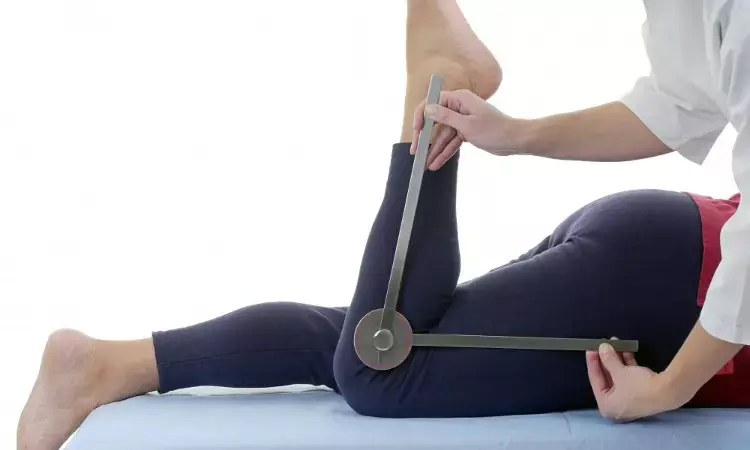- Home
- Medical news & Guidelines
- Anesthesiology
- Cardiology and CTVS
- Critical Care
- Dentistry
- Dermatology
- Diabetes and Endocrinology
- ENT
- Gastroenterology
- Medicine
- Nephrology
- Neurology
- Obstretics-Gynaecology
- Oncology
- Ophthalmology
- Orthopaedics
- Pediatrics-Neonatology
- Psychiatry
- Pulmonology
- Radiology
- Surgery
- Urology
- Laboratory Medicine
- Diet
- Nursing
- Paramedical
- Physiotherapy
- Health news
- Fact Check
- Bone Health Fact Check
- Brain Health Fact Check
- Cancer Related Fact Check
- Child Care Fact Check
- Dental and oral health fact check
- Diabetes and metabolic health fact check
- Diet and Nutrition Fact Check
- Eye and ENT Care Fact Check
- Fitness fact check
- Gut health fact check
- Heart health fact check
- Kidney health fact check
- Medical education fact check
- Men's health fact check
- Respiratory fact check
- Skin and hair care fact check
- Vaccine and Immunization fact check
- Women's health fact check
- AYUSH
- State News
- Andaman and Nicobar Islands
- Andhra Pradesh
- Arunachal Pradesh
- Assam
- Bihar
- Chandigarh
- Chattisgarh
- Dadra and Nagar Haveli
- Daman and Diu
- Delhi
- Goa
- Gujarat
- Haryana
- Himachal Pradesh
- Jammu & Kashmir
- Jharkhand
- Karnataka
- Kerala
- Ladakh
- Lakshadweep
- Madhya Pradesh
- Maharashtra
- Manipur
- Meghalaya
- Mizoram
- Nagaland
- Odisha
- Puducherry
- Punjab
- Rajasthan
- Sikkim
- Tamil Nadu
- Telangana
- Tripura
- Uttar Pradesh
- Uttrakhand
- West Bengal
- Medical Education
- Industry
Knee ROM measurements in smartphone app comparable to ones made by goniometer physically

P.W. Knapp et al. found in a study that - Digital app measurements were comparable to measurements made by either a surgeon or physical therapist with a manual goniometer in the clinical setting and may be beneficial for measuring and monitoring patients' range of motion remotely.
Digital technology has emerged as a useful tool for preoperative and postoperative patient engagement and for remote patient monitoring. Smartphones are equipped with motion-sensing technology, and apps can be designed which use these features to create a simple method for measuring range of motion.
The authors conducted a study to determine the accuracy of digital technology in assessing knee range of motion using a smartphone app, compared to traditional goniometric measurements in an office setting.
Fifty-three (53) patients in a clinical practice were enrolled for the study.
Patients were included regardless of the reason for clinical visit; they did not need to be surgical patients as the goal of the study was to determine the correlation between manual goniometric and digital measurements.
Patients were excluded if there was a history of acute traumatic injury to the knee limiting ROM.
In addition to ROM, patient height, weight, and body mass index (BMI) were also recorded. BMI measurements were included to address clinical concerns with accuracy associated with patients' body habitus.
The App vocalizes instructions to the patient or provider on the proper technique. The protocol involves placing the phone on the anterior thigh and, when instructed, sliding the phone down to the mid tibia region. The App then calculates and states the calculated ROM. Patients were then immediately brought to the hospital for readings with a manual goniometer by surgeon & physical therapist.
Three separate measurements were taken during the patient encounter: (1) the surgeon, (2) the app, and (3) the physical therapist.
Intraclass correlations were computed to assess the agreement between (1) the surgeon and app and (2) that between the physical therapist and surgeon.
The observations of the study were –1.When measuring flexion, the correlation between either the surgeon or therapist with the app was good, whereas the comparison between the surgeon and therapist was moderate.
2.All extension measurement comparisons, between the app, surgeon, and therapist, showed moderate correlation.
3.Limits of agreements showed that 80% of the difference between surgeon and app is within 10 degrees for extension and 11 degrees for flexion.
4.Body mass index did not affect the accuracy of the measurements.
The authors concluded that - Newer technology that allows for remote patient monitoring continues to provide appealing applications for surgeons and patients. They demonstrated that the studied digital application measuring remote knee ROM was comparable to manual measurements made by either a surgeon and/or PT. Further investigation is necessary to track long-term outcomes and appropriate utilization of this technology in a clinical setting.
Further reading:
Comparison of a Smartphone App to Manual Knee Range of Motion Measurements
Paul W. Knapp, Robert A. Keller, Kathryn A. Mabee, Jing Shi, Raji Pillai, Nicholas B. Frisch.
Arthroplasty Today 15 (2022) 43-46
https://doi.org/10.1016/j.artd.2021.09.005
MBBS, Dip. Ortho, DNB ortho, MNAMS
Dr Supreeth D R (MBBS, Dip. Ortho, DNB ortho, MNAMS) is a practicing orthopedician with interest in medical research and publishing articles. He completed MBBS from mysore medical college, dip ortho from Trivandrum medical college and sec. DNB from Manipal Hospital, Bengaluru. He has expirence of 7years in the field of orthopedics. He has presented scientific papers & posters in various state, national and international conferences. His interest in writing articles lead the way to join medical dialogues. He can be contacted at editorial@medicaldialogues.in.
Dr Kamal Kant Kohli-MBBS, DTCD- a chest specialist with more than 30 years of practice and a flair for writing clinical articles, Dr Kamal Kant Kohli joined Medical Dialogues as a Chief Editor of Medical News. Besides writing articles, as an editor, he proofreads and verifies all the medical content published on Medical Dialogues including those coming from journals, studies,medical conferences,guidelines etc. Email: drkohli@medicaldialogues.in. Contact no. 011-43720751


